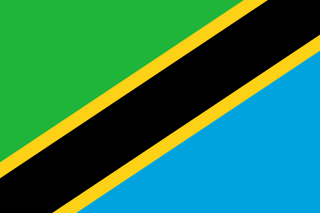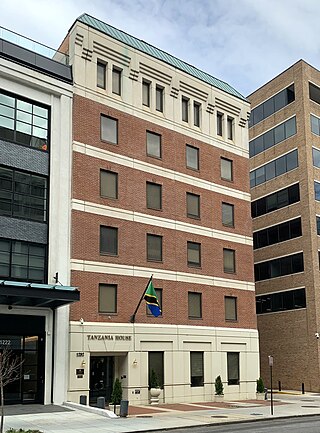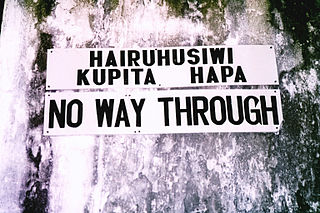Related Research Articles

The Maasai are a Nilotic ethnic group inhabiting northern, central and southern Kenya and northern Tanzania, near the African Great Lakes region. Their native language is the Maasai language, a Nilotic language related to Dinka, Kalenjin and Nuer. Except for some elders living in rural areas, most Maasai people speak the official languages of Kenya and Tanzania—Swahili and English.

Tanzania, officially the United Republic of Tanzania, is a country in East Africa within the African Great Lakes region. It is bordered by Uganda to the northwest; Kenya to the northeast; the Indian Ocean to the east; Mozambique and Malawi to the south; Zambia to the southwest; and Rwanda, Burundi, and the Democratic Republic of the Congo to the west. According to the 2022 national census, Tanzania has a population of around 62 million, making it the most populous country located entirely south of the equator.
Haya (Oruhaya) is a Bantu language spoken by the Haya people of Tanzania, in the south and southwest coast of Lake Victoria. In 1991, the population of Haya speakers was estimated at 1,200,000 people. Its closest relative is the Nyambo language and it is also closely related to the languages of southwest Uganda such as Nkore-Kiga, Rutooro and Runyoro which all form a group called Rutara.
The Military ranks of Tanzania are the military insignia used by the Tanzania People's Defence Force. Being a former British colony, Tanzania shares a rank structure similar to that of the United Kingdom.

Karagwe is one of the eight districts of the Kagera Region of Tanzania. It is bordered to the north by Uganda, to the east by the Bukoba Rural District, to the southeast by the Muleba District, to the south by the Ngara District and to the west by Republic of Rwanda, from which it is separated by the River Kagera. Small lakes such as the Ikimba, Burigi, Rushwa, and Rwakajunju provide fishing opportunities for residents of the Karagwe District. The district covers and area of 5,134 square kilometres (1,982 sq mi).
The Kahe is an ethnic and linguistic group based southeast of Moshi in Kilimanjaro Region Tanzania. The Kahe language, or Kikahe, is in the Chagga cluster of Bantu languages. Three dialects are recognized: Kimwangaria, Msengoni and Kichangareni. Kikahe is spoken by 9,130 people, and is one of the smaller language communities in Tanzania.

Tanzania first participated at the Olympic Games in 1964, and has sent athletes to compete in every Summer Olympic Games except for the boycotted 1976 Games and has never participated in the Winter Olympic Games.
The Great Lakes Bantu languages, also known as Lacustrine Bantu and Bantu zone J, are a group of Bantu languages of East Africa. They were recognized as a group by the Tervuren team, who posited them as an additional zone to Guthrie's largely geographic classification of Bantu.

Around seven Tanzanian sign languages were independently developed among deaf students in separate Tanzanian schools for the deaf, starting in 1963. However, the use of several is forbidden by their respective schools. In 1984, a standardized Tanzanian Sign Language was proposed by the Tanzania Association for the Deaf, using common or similar signs where these exist in schools that allowed research. However, it has not been officially implemented, and there remains little influence between the languages. A dictionary has been produced, while still several online resources, e.g. SignWiki, PDFs or YouTube-Videos, are published by different entities. With TSL as with other languages, language standardization comes with some politics and issues of power involved. In 2019, the prime minister, when visiting the national celebrations of the International Week of the Deaf in Iringa, announced another program working on “Harmonization and Standardisation of Tanzanian Sign Language”.

Tanzania made its Paralympic Games début at the 1992 Summer Paralympics in Barcelona. It was represented by a single competitor, male tennis player Noorelain sharrif. The country was then absent from the Paralympics until 2004, when it sent two runners: Willbert Costantino in the men's 800m race, and Mwanaidi Ng Itu in the women's 100m and 200m sprints. In 2008, Tanzania's sole competitor was Justine Ernest, in the men's shot put.
The Ibanda-Kyerwa National Park, previously Ibanda Game Reserve, is a national park in Tanzania, with the IUCN category II located within Kyerwa District of the Kagera Region of Tanzania.

The Embassy of the United Republic of Tanzania in Washington, D.C. is the diplomatic mission of Tanzania in the United States. It is located at 1232 22nd Street NW in the West End neighborhood. The mission is also accredited to Mexico.

Tanzania is a multilingual country. There are many languages spoken in the country, none of which is spoken natively by a majority or a large plurality of the population. Swahili and English, the latter being inherited from colonial rule, are widely spoken as lingua francas. They serve as working languages in the country, with Swahili being the official national language. There are more speakers of Swahili than English in Tanzania.

Grande-Terre is the main island of the French overseas region of Mayotte. The island is located in the northern Mozambique Channel in the Indian Ocean, namely between northwestern Madagascar and northeastern Mozambique.
The Tanzania Intelligence and Security Service (TISS) is the national intelligence and security agency of Tanzania.
Arthur Asa Grandville Carscallen (1879–1964), was a Seventh-day Adventist pastor, missionary, administrator, linguist, and publisher.
The Rutara or Runyakitara languages are a group of closely related Bantu languages spoken in the African Great Lakes region. They include languages such as Runyoro, Runyankore, Rukiga and Ruhaya. The language group takes its name from the Empire of Kitara.
Capital punishment is a legal penalty in Tanzania. Tanzania has two capital offences: treason and murder. The death penalty is the mandatory sentence for murder.
References
- ↑ Nyambo at Ethnologue (18th ed., 2015) (subscription required)
- ↑ Jouni Filip Maho, 2009. New Updated Guthrie List Online
- ↑ "Tanzania".
- Josephat M. Rugemalira (2005). A Grammar of Runyambo. Languages of Tanzania Project. ISBN 9987-691-03-X.